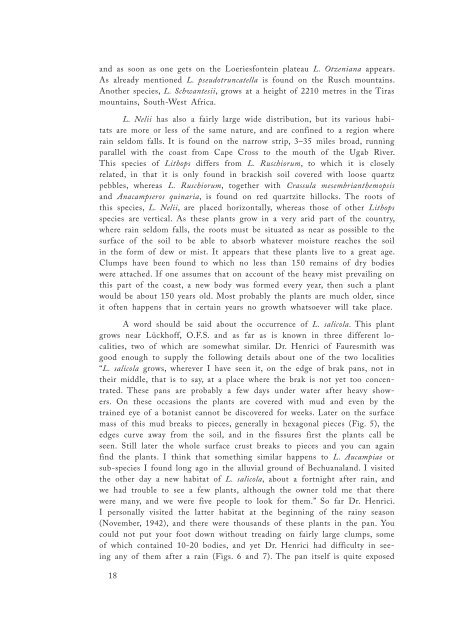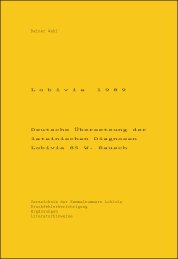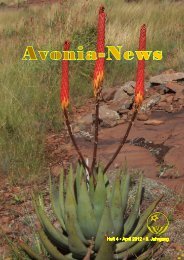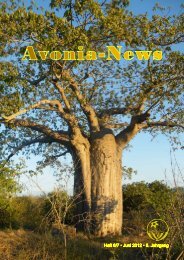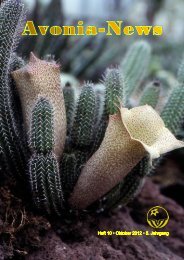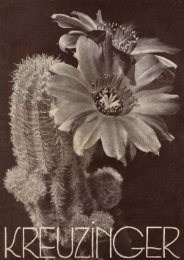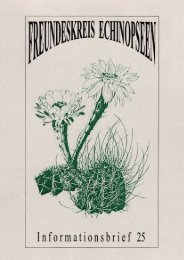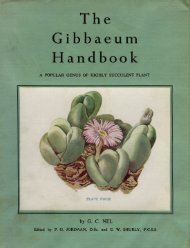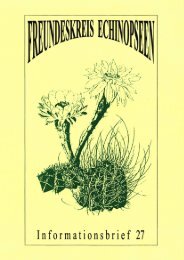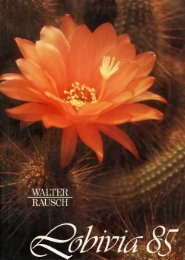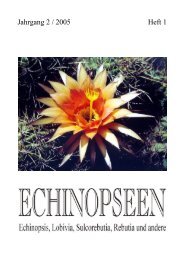Lithops - Au Cactus Francophone
Lithops - Au Cactus Francophone
Lithops - Au Cactus Francophone
Create successful ePaper yourself
Turn your PDF publications into a flip-book with our unique Google optimized e-Paper software.
<strong>Lithops</strong> > <strong>Lithops</strong><br />
and as soon as one gets on the Loeriesfontein plateau L. Otzeniana appears.<br />
As already mentioned L. pseudotruncatella is found on the Rusch mountains.<br />
Another species, L. Schwantesii, grows at a height of 2210 metres in the Tiras<br />
mountains, South West Africa.<br />
L. Nelii has also a fairly large wide distribution, but its various habi<br />
tats are more or less of the same nature, and are confined to a region where<br />
rain seldom falls. It is found on the narrow strip, 3–35 miles broad, running<br />
parallel with the coast from Cape Cross to the mouth of the Ugab River.<br />
This species of <strong>Lithops</strong> differs from L. Ruschiorum, to which it is closely<br />
related, in that it is only found in brackish soil covered with loose quartz<br />
pebbles, whereas L. Ruschiorum, together with Crassula mesembrianthemopsis<br />
and Anacampseros quinaria, is found on red quartzite hillocks. The roots of<br />
this species, L. Nelii, are placed horizontally, whereas those of other <strong>Lithops</strong> <strong>Lithops</strong> > <strong>Lithops</strong><br />
species are vertical. As these plants grow in a very arid part of the country,<br />
where rain seldom falls, the roots must be situated as near as possible to the<br />
surface of the soil to be able to absorb whatever moisture reaches the soil<br />
in the form of dew or mist. It appears that these plants live to a great age.<br />
Clumps have been found to which no less than 150 remains of dry bodies<br />
were attached. If one assumes that on account of the heavy mist prevailing on<br />
this part of the coast, a new body was formed every year, then such a plant<br />
would be about 150 years old. Most probably the plants are much older, since<br />
it often happens that in certain years no growth whatsoever will take place.<br />
A word should be said about the occurrence of L. salicola. This plant<br />
grows near Lückhoff, O.F.S. and as far as is known in three different lo<br />
calities, two of which are somewhat similar. Dr. Henrici of Fauresmith was<br />
good enough to supply the following details about one of the two localities<br />
“L. salicola grows, wherever I have seen it, on the edge of brak pans, not in<br />
their middle, that is to say, at a place where the brak is not yet too concen<br />
trated. These pans are probably a few days under water after heavy show<br />
ers. On these occasions the plants are covered with mud and even by the<br />
trained eye of a botanist cannot be discovered for weeks. Later on the surface<br />
mass of this mud breaks to pieces, generally in hexagonal pieces (Fig. 5), the<br />
edges curve away from the soil, and in the fissures first the plants call be<br />
seen. Still later the whole surface crust breaks to pieces and you can again<br />
find the plants. I think that something similar happens to L. <strong>Au</strong>campiae or<br />
sub species I found long ago in the alluvial ground of Bechuanaland. I visited<br />
the other day a new habitat of L. salicola, about a fortnight after rain, and<br />
we had trouble to see a few plants, although the owner told me that there<br />
were many, and we were five people to look for them.” So far Dr. Henrici.<br />
I personally visited the latter habitat at the beginning of the rainy season<br />
(November, 1942), and there were thousands of these plants in the pan. You<br />
could not put your foot down without treading on fairly large clumps, some<br />
of which contained 10 20 bodies, and yet Dr. Henrici had difficulty in see<br />
ing any of them after a rain (Figs. 6 and 7). The pan itself is quite exposed<br />
18


